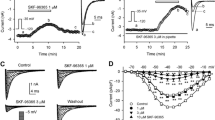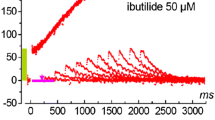Abstract
Tedisamil has been described as a selective inhibitor of a fast inactivating transient outward current (ito,f) in rat ventricular myocytes. Because recent reports demonstrated the existence of a second slowly inactivating transient component (ito,s) we investigated ito,s and differentiated the effects of tedisamil on both transient outward current components and their influence on action potential duration. Standard electrophysiological techniques were used for whole cell recordings at 24–26° C from enzymatically isolated myocytes. Inhibition of ito,f by tedisamil was the result of an acceleration of inactivation at positive test potentials with a concentration for halfmaximal inhibition (EC50) of 4–7 μmol/l, which is confirmatory to reports from other investigators. Our new results show that ito,s is more sensitive to tedisamil with an EC50 of 0.5 μmol/l. Furthermore the pattern of ito,s inhibition is different compared with ito,f, because inactivation of ito,s is not accelerated by tedisamil. Instead the amplitude of the steady state inactivation curve of ito,s is attenuated which indicates a reduction of maximally available current. Ito,s was evaluated by three different methods as time-dependently inactivating current (7.5 s test pulse duration), voltage-dependently inactivated current and tedisamil-sensitive current. All approaches yield similar inactivation curves. The potential for halfmaximal inactivation of ito,s lies about 35 mV more negative than that for ito,f and the slope factor (K = –23 mV) is different to that of ito,f (K = –3 mV). Effectiveness of tedisamil-induced modulation of ito,f and ito,s on action potential repolarization was tested. Action potentials stimulated at 0.5 Hz were not prolonged by 1 μmol/l tedisamil (dominant ito,s block) at a repolarization level of 0 mV but prolonged to about 120% of control at –70 mV. This indicates that ito,f was sufficient to guarantee a regular early repolarization whereas decrease of ito,s delayed the final repolarization.
In conclusion, the observation that tedisamil inhibits ito,f and ito,s differently supports the hypothesis that the two ito-components are related to two different channel populations expressed in rat ventricular myocytes.
Similar content being viewed by others
Author information
Authors and Affiliations
Additional information
Received: 28 July 1997 / Accepted: 3 December 1997
Rights and permissions
About this article
Cite this article
Berger, F., Borchard, U., Hafner, D. et al. Different inhibition patterns of tedisamil for fast and slowly inactivating transient outward current in rat ventricular myocytes. Naunyn-Schmiedeberg's Arch Pharmacol 357, 291–298 (1998). https://doi.org/10.1007/PL00005170
Issue Date:
DOI: https://doi.org/10.1007/PL00005170




